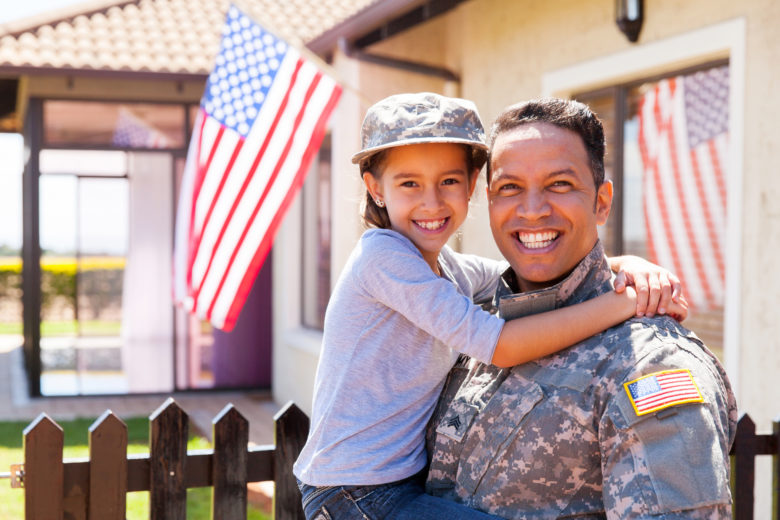
This Veterans Day, we pause to honor the sacrifice of our active duty military, veterans and their families. It is also important to recognize the struggles that come with the uncertainty of military life, many of which are unseen by civilians. As a military spouse and a dietitian living in the military community, I have witnessed some of these struggles. For families both overseas and stateside, frequent moves present spouse employment challenges, which impacts the ability to contribute to family earnings, and saving up for these moves also means less flexibility to spend in the moment. Oftentimes the cost of nearby childcare exceeds minimum wage earnings and spouses choose not to work. Military bases are frequently far away from big cities, which can translate to limited resources and higher food costs. Finally, we don’t get to pick where we live, and are often far away from family, which can translate into an added budget strain for those that want to visit family during the year.
As a result of these challenges, many of our U.S.-based active duty service men and women, military veterans and their families are living at or below the poverty line and have a high prevalence of food insecurity. While they would benefit from existing food assistance programs, parameters are not in place to ensure this happens.
A Silent Struggle to Survive
According to the Defense Commissary Agency, service members on active duty spent over $21 million on Supplemental Nutrition Assistance Program benefits at commissaries from September 2014 through August 2015. The SNAP Retailer Management 2015 Annual Report indicates that over $80.2 million were spent at military commissaries during the same time period, suggesting that many veterans and military families are also facing food insecurity issues.
In a recent study published in Public Health Nutrition, researchers found that one in four veterans of the Iraq and Afghanistan wars reported past-year food insecurity and 12 percent reported very low food insecurity. In a subsequent study, researchers focused on food insecurity among veterans in the Veterans Aging Cohort Study. Of the 6,709 veterans enrolled in VACS, 24 percent reported being food insecure, and this was further associated with worse control of hypertension, diabetes, HIV and depression, among other things.
While military families facing financial hardships have access to government and charitable food assistance programs, many barriers prevent service members from utilizing these benefits, including limited awareness of available food assistance programs and inconsistent eligibility for programs, particularly with regard to the Basic Allowance for Housing.
Government and charitable food assistance programs are not widely publicized on military bases or as part of returning service members resources. There is often a stigma associated with receiving SNAP benefits; however, this stigma does not apply to receiving WIC benefits because WIC is viewed as more of a health and nutrition benefit rather than a program for those with financial and food assistance needs.
Inconsistent program eligibility is also an impediment to food insecurity assistance. One clear example is the inclusion of the Basic Allowance for Housing, or BAH, for certain programs. While a service member’s base pay stays the same regardless of station location, the BAH rate increases or decreases based on zip code. BAH is included in SNAP benefit eligibility requirements, resulting in variable eligibility for these benefits based on location. By contrast, Special Supplemental Nutrition Program for Women, Infants and Children legislation allows state agencies to exclude portions of a service member’s pay when determining eligibility. This inconsistency creates confusion about service members’ ability to qualify for food assistance programs.
Strategies and Resources to Help 
- Raise awareness of SNAP benefits and other existing programs to reduce stigma associated with receiving assistance.
- Include information on existing food assistance programs during in-processing at new duty stations. Availability and eligibility of programs can vary from state to state — although a family may not have qualified at a previous base, new circumstances and state guidelines may be different.
- Deliberately and consistently coordinate information and resources with locally developed initiatives, such as food pantries on bases.
- MAZON: A Jewish Response to Hunger
Improving knowledge of and access to food assistance programs can significantly decrease health care costs and improve the performance of active duty service members. More importantly, giving our active duty military, veterans and their families access to nutritious food is a tangible way to show our gratitude not just on Veterans Day, but all year.
Melinda Boyd, MPH, MHR, RD, is a registered dietitian and military spouse living in England. She is co-author of Train Your Brain to Get Thin, and blogs at NutrFoodTrvl.blogspot.com. Follow her on Twitter.
(Photo: Thinkstock/michaeljung)


